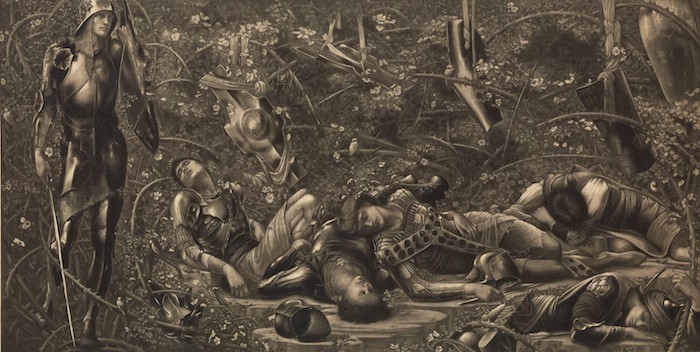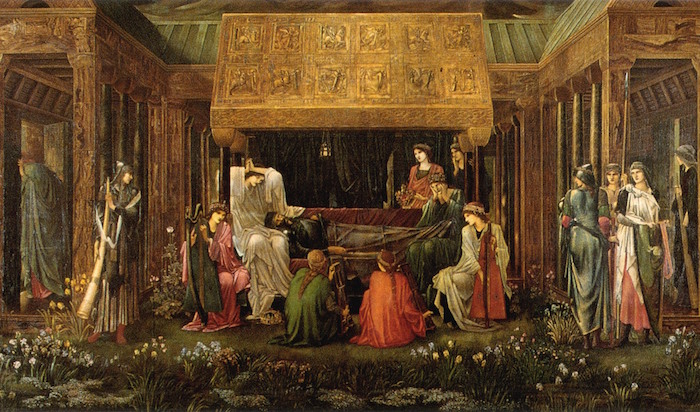Magic items! No fantasy campaign is complete without them – and medieval stories about King Arthur and his knights are full of them. Here, then, are seven enchanted weapons and pieces of armor from Arthurian myth!

Bronllafyn Short-Broad, the sword of Osla Big-Knife, from Culhwch and Olwen (ca. 11th-12th century). When the sheathed sword is placed in a narrow spot in a river, it forms a bridge sufficient to carry all of Arthur’s armies.
The shoes of Sgilti Lightfoot, from Culhwch and Olwen. He is a messenger of Arthur, and a man so light no reed or blade of grass ever bends under his weight. When traveling through a forest, he runs along the tops of trees. He needs no roads because grass and heather are as firm under his feet as paving stones. Wearing Sgilti’s shoes makes you as light as he is.
Retho’s pelt, from Historia Regum Britanniae (ca. 1136). Retho was a giant who lived on Mt. Arvaius (location unknown, but it might be Mt. Snowdon in Wales). He had a pelt woven from the beards of all the kings who fought him and died. When Arthur confronted Retho, the giant gave the king a chance to back down: if Arthur would shave his beard and hand it over, Retho would let him live – and would put the high king’s whiskers in a point of pride above all the others in the pelt. Instead, Arthur slew Retho and claimed the giant’s pelt and beard as trophies. Retho’s pelt provides great backstory for a shaggy but potent magic cloak. Some part of the commanding spirit of these kings may live on in their beards, giving a bonus to command checks. The pelt may also function as a Belt of Giant’s Strength. Retho himself is a great random encounter: a giant highwayman who demands your beard or your life!

The Red Armor of the Red Knight and Sir Perceval from Perceval (ca. 1180). This armor belonged to the insolent Red Knight of Quinqueroy, a mortal foe of King Arthur, who stole the King’s goblet and claimed his lands. The Red Knight was then surprised by Perceval the Welshman, who slew him with a javelin and took the armor. Perceval is an interesting character: a young man so ignorant and naive as to be incapable of morality, except for faithfully (and sometimes inappropriately) following the advice of his mother and his mentor. Indeed, he is so naive he does not know his own name, merely guessing that it might be ‘Perceval’. In his ignorance, he reflexively solves his problems with violence. Despite having only one afternoon of formal training with the lance and none with the sword, he bests every opponent, thanks, perhaps, to the Red Armor. You can read the text as suggesting that the armor fits any wearer perfectly, and – while wearing it – you will defeat every foe you face in knightly combat. At the table, I’d restrict that to every human foe, and say that if you become aware of its power, it no longer works for you. Once you figure out what it does, you have to find a patsy to wear it for you: an ignorant Perceval of your very own.
Trabuchet’s sword, from Perceval: a steel sword with a hilt of Arabian gold and a scabbard decorated with Venetian golden embroidery. Its blade is stamped with the maker’s mark of Trabuchet, a great smith, who made only three swords this fine. It will break only when exposed to a single perilous situation, known only to the smith. In Perceval, we never learn what that moment is, as the work was never finished. At your table, you might have the sword break only when it crosses blades with one of its brothers. You can give the villain one of Trabuchet’s other two swords, and have the PC who carries a Trabuchet sword recognize it when they meet. To keep the PC interested in the sword (and using it) until she meets the villain, you’ll want to give it an enchantment beyond being completely unbreakable. Consider stealing some properties from the Lance of the Black Knight, below. Ideally, Trabuchet’s sword should be a gift from a mentor, so the PCs have a chance to learn the sword’s legend.

The Lance of the Black Knight, from Perlesvaus (ca. 1210). The Black Knight in this story is a devil in human flesh. Alas, he bears little resemblance to the John Cleese character in Monty Python And The Quest For The Holy Grail. The Black Knight carries a lance that burns from the tip to the wielder’s hand. Though the flames are dangerous, the lance only deals extra fire damage on its first successful strike. Once it tastes the blood of its foe, the flames are extinguished. Much worse, the wounds the lance inflicts can only be healed by wrapping them in a bandage soaked in the blood of the lance’s wielder. And – as if fire damage on the first hit and being tricky to heal from weren’t enough – the lance has one final property. Normally, when a lance strikes its target, it either bounces off, shatters, or drives right through the target’s body. A lance that shatters still strikes a terrible blow: it’s delivering the force of a galloping horse and armored rider, and it shatters only because the stout wooden pole is under so much strain it breaks apart. The Lance of the Black Knight doesn’t shatter. It delivers every pound of force without shivering. In D&D terms, it has a much higher chance of delivering a critical hit.
The Shield of the Dragon Knight, from Perlesvaus. This shield is great for an enemy NPC. In the middle of the shield is a dragon’s head that breaths sulfurous fire. When Perlesvaus faces the Dragon Knight, the dragon head burns up the poor hero’s lance right up to his fist! But when Perlesvaus strikes a mighty blow against the shield, he splits it right up to the head, and some of the dragon’s fire gets on Perlesvaus’ sword. Now our hero is wielding a badass flaming sword! (Hence why the shield is good for an enemy NPC – a critical hit against the target catches your sword on fire.) During the fight, a conveniently-placed maiden cries out to Perlesvaus that the Dragon Knight can only be defeated by a single blow to a single spot, but she doesn’t know where. Perlesvaus figures out the answer – the dragon head! – stabs it in the mouth, and the head turns around and burns the Dragon Knight to a crisp. This sort of minor puzzle can be a lot of fun during combat, but you’ll probably not want to use a convenient maiden to introduce it. Instead, consider letting a PC roll to recall an old bit of lore.






